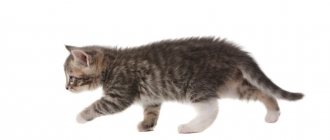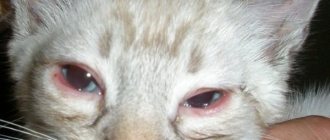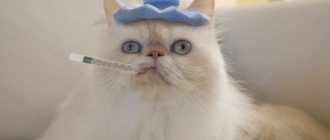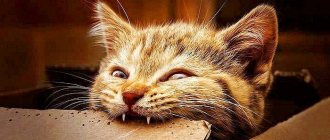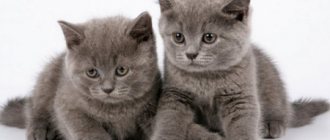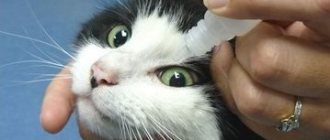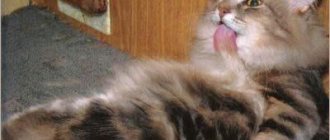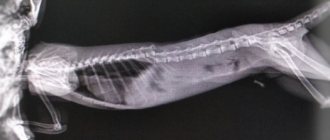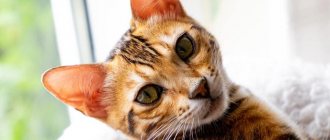Although many cat caregivers believe that frequent vomiting is normal, the fact remains that acute episodes of vomiting or intermittent vomiting over time are always a reason to consult a veterinarian and can have many different causes. In this article, we will focus on describing the most common ones when explaining why our cat is vomiting white foam.
It is good that we observe whether the vomiting is acute (multiple vomiting in a short time) or chronic (vomiting 1-2 times a day or almost never goes into remission), and if, in addition, there are other symptoms such as diarrhea, report this to your veterinarian.
Why does a cat vomit after feeding?
If, after the next meal, the cat vomits dry food and has general weakness and apathy, you should not immediately run to the veterinarian. To begin with, you just need to find out the source of the problem and observe the actions of your pet. A cat may vomit food for many reasons.
Binge eating
Cats do not experience a pronounced feeling of fullness, so overeating is one of the most common reasons that causes nausea and vomiting. This happens if the owner does not follow the rules of feeding the pet and offers him a non-standard portion of food.
When dry food granules enter the stomach, they swell, cause discomfort, and contribute to severe pain. An excess can cause not only discomfort in the stomach, but also nausea or vomiting.
Hasty eating
Many cats are very interested in eating, regardless of their level of hunger and body needs. This is why rapid ingestion of dry food can clog the stomach and is often accompanied by vomiting and general weakness.
If your cat does not know how to control the speed of eating, and often vomits after dry food, you can prevent such consequences in the following ways:
- reduce the amount of food, divide the daily amount of dry food into 5-6 meals;
- use a special bowl with ridges that will automatically slow down rapid eating;
- create a comfortable environment for your pet, make sure that there are no other pets near him during meals.
Compliance with these rules will eliminate the risk of overeating and consequences such as vomiting in the kitten.
Abrupt change of feed
Changing food is always stressful for a cat, which manifests itself not only in the form of lack of appetite, but also in the occurrence of nausea. If a cat vomits from a new dry food, the following reasons may contribute to this:
- intolerance to components;
- poor quality product;
- stressful situation.
Such consequences can be avoided by following general recommendations regarding changing food. You need to switch to a new product within 1-2 weeks, while gradually adding new food to the standard diet.
Expired or low-quality food
If your cat vomits dry food immediately after eating, the cause may be the expiration date or poor quality of the product. When purchasing food, you must pay attention to the composition, the ratio of animal and plant components.
The more ingredients of animal origin it contains, the tastier and better quality the dry food will be.
Food intolerance
If after eating a cat begins to vomit, he loses his activity and experiences general weakness, this indicates a food intolerance to the product. This can also be confirmed by stool disorder.
Attention! Often the cause of vomiting is not the food itself, but a separate component in its composition. Often it is a source of protein.
Mixed feeding
The combination of dry food with other products often provokes nausea in a cat, causes general malaise, loss of appetite and other symptoms. This is due to different processes of food digestion.
For example, a combination of dry food with dairy products, which require a lot of resources to break down, can cause illness.
In order not to encounter such a manifestation, it is necessary to dilute the food in separate portions, and do not mix several products at one time.
Adequate nutrition
The optimal solution in modern conditions is high-quality, ready-to-eat food, dry or wet, without “ready-made” additives. It is possible to provide a balanced diet prepared at home, but it is much more difficult. To calculate the norms of vitamins and microelements, it is advisable to involve a nutritionist.
A cat's natural diet is 24 hours a day, often and gradually. It is better to always have dry food in a bowl - perhaps this will save you from annoying “awakenings” at dawn, when cats are especially active.
Place the food bowl at least two feet away from the water bowl and litter box. The delimitation of these territories is very important for his well-being. Free access to fresh, clean water is vital. Many cats love to drink running water from a tap or fountain.
Recently popular “food toys” have been useful, from which the cat takes food while playing, with some effort. This satisfies your pet's hunting instinct, keeps him busy for a long time and helps avoid overeating and other behavioral disorders.
What to do if your cat vomits undigested food
If a cat is vomiting from dry food, first you need to determine why this happened, and only then think about what to do in such a situation. A one-time adverse reaction rarely poses a visible threat to the kitten's health, but it is still a condition worth paying attention to. You can avoid such manifestations if you follow certain requirements:
- Feeding in small portions. Cats' stomachs are small, so they need a minimal amount of food to fully satiate.
- Checking the quality of food. You should not feed your cat dry food if its expiration date expired yesterday. One day of delay of a product can also lead to unforeseen consequences.
- Separate meals. Dry food is combined only with water; any other products, in particular dairy, can harm the stomach.
Only a correct and careful approach to organizing the cat’s nutrition will avoid serious complications.
Important! If high-quality food, separate feeding and control of overeating do not stop the vomiting, you should urgently contact a veterinarian. Often, regular vomiting of undigested food indicates serious disturbances in the functioning of the gastrointestinal tract.
Other causes of vomiting after eating
A cat does not always feel sick and vomit from poor-quality food or overeating; there are many more reasons for this phenomenon.
Hairballs in the stomach
Nausea can be caused by hairballs that enter the cat's stomach during the washing process. To dissolve them, various malt pastes are used, which can be purchased at any veterinary pharmacy.
Attention! Very often, it is long-haired cat breeds that face this problem.
Worm infestations
A kitten may vomit if the body is seriously damaged by worms. Their appearance in the stomach causes serious intoxication, disrupts the functioning of the digestive system, and negatively affects internal organs. To control the situation, it is important to contact a veterinarian once every six months, undergo a routine examination and worm your pet.
Poisoning and infectious diseases
Vomiting is often accompanied by infectious diseases, which the owner may not even think about. If your cat's behavior in everyday life does not cause concern, but nausea and vomiting occur after eating, you should contact your veterinarian.
The viral infection spreads very quickly. If its rapid development is not prevented in time, the consequences can be the most unforeseen, including death.
Definitely an emergency
Call your doctor immediately if you notice any of the following symptoms in your cat.
- Repeated painful vomiting during the day, especially if there are other symptoms of the disease: diarrhea (loose, frequent stools) or, conversely, constipation; weakness, lethargy, refusal to eat, trembling (trembling), excessive salivation, fainting, presence of fragments of inedible objects in the vomit. We may be talking about severe poisoning, intestinal obstruction, the development or exacerbation of any serious internal pathology that you may not have known about before.
- Single or multiple vomiting mixed with blood. Vomit is bright red or pink. Often such vomiting indicates that something very serious has happened: internal bleeding is possible due to injuries, ulcers, constipation and cancer.
- More than green or yellow vomit (unless the color is due to the cat eating grass or yellowish food, but due to bile in the stomach).
- The presence of helminths (even if it is just one parasite) or their fragments (white “grains”) in the vomit. When this happens, it means that the number of parasites in the cat's intestines is very high and requires urgent and serious treatment. All cats should be regularly treated for worms and fleas throughout their lives. Don't neglect them.
- “Mild” but frequent (eg daily) vomiting for more than a week. The cat's condition is not necessarily severe, but in any case, consulting a doctor is important. If it is possible to identify the disease, treatment is prescribed. Your doctor can also advise you on how to change your pet's diet or feeding schedule.
To take your cat to the veterinarian, try to place the animal in the carrier as gently and stress-free as possible. Place something soft at the bottom, such as a blanket that smells like your cat, and an absorbent diaper on top that can be replaced if it gets dirty. Take with you a supply of such diapers, dry and wet wipes, and garbage bags. Cover the carrier with a towel or, in cold weather, a blanket - this will make the cat feel safer and not freeze on the road in winter. Place the container in the back seat of the vehicle with the seat belt securely fastened, or on the floor behind the driver's seat. In the clinic, try to place the container not on the floor, but on a chair or a special stand - this will reduce the level of stress for the cat. Do not remove your towel while waiting for your appointment. The same towel will be convenient for you to hold your cat when removing it from the carrier.
Prepare in advance to describe your symptoms to your doctor. You will also need to indicate the brand or type of food your cat is receiving, describe the feeding method, indicate whether the cat has any chronic illnesses in the past, and how deworming treatment is administered. What has changed in the cat’s diet and in the house in general in recent days? What chemicals or medications may be available to the cat? Remember when your cat's symptoms first appeared and how they developed over time. Every “little thing” is taken into account: the appearance and behavior of the cat, the nature of the discharge, stool, urination... and, of course, the characteristics of the vomiting itself.
When to see a doctor
A veterinarian's help may be needed in the following situations:
- vomiting does not stop during the day;
- apathy occurs;
- the pet becomes inactive;
- loss of appetite;
- stool is disturbed.
In order not to put the cat’s health and life at risk, at the first serious symptoms it is important to immediately contact a veterinarian, determine the main causes of vomiting and malaise, and select an effective treatment. After all, high-quality food, healthy sleep and the love of the owner are the most important things in the life of every cat.
